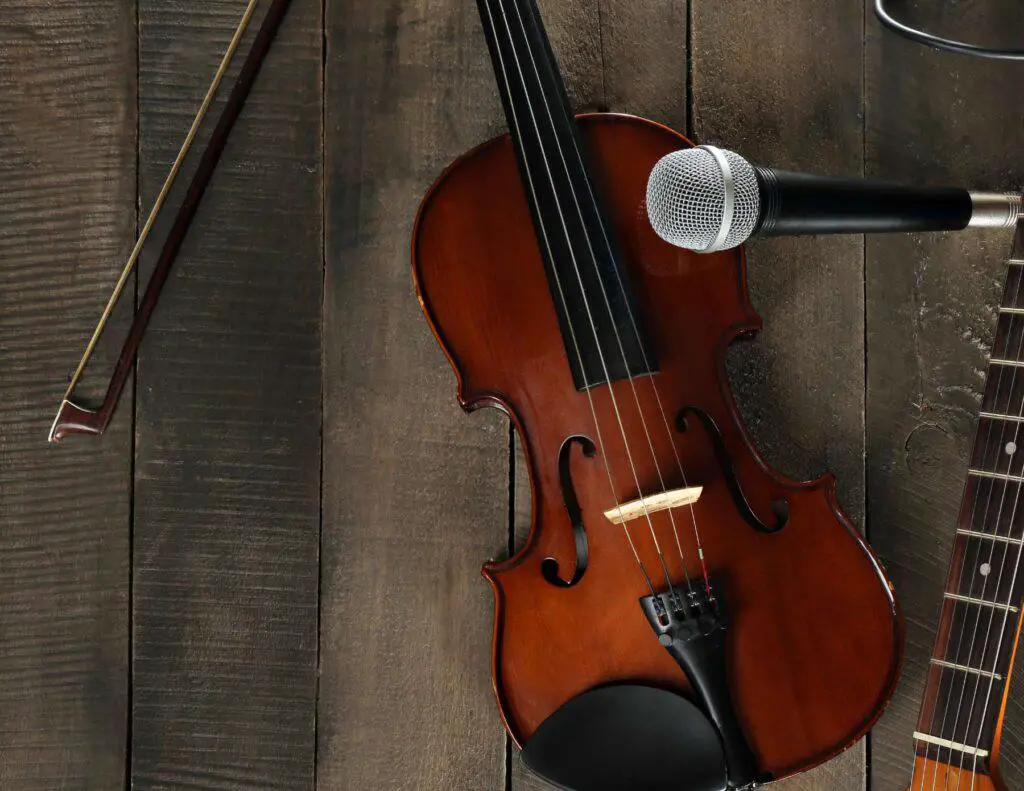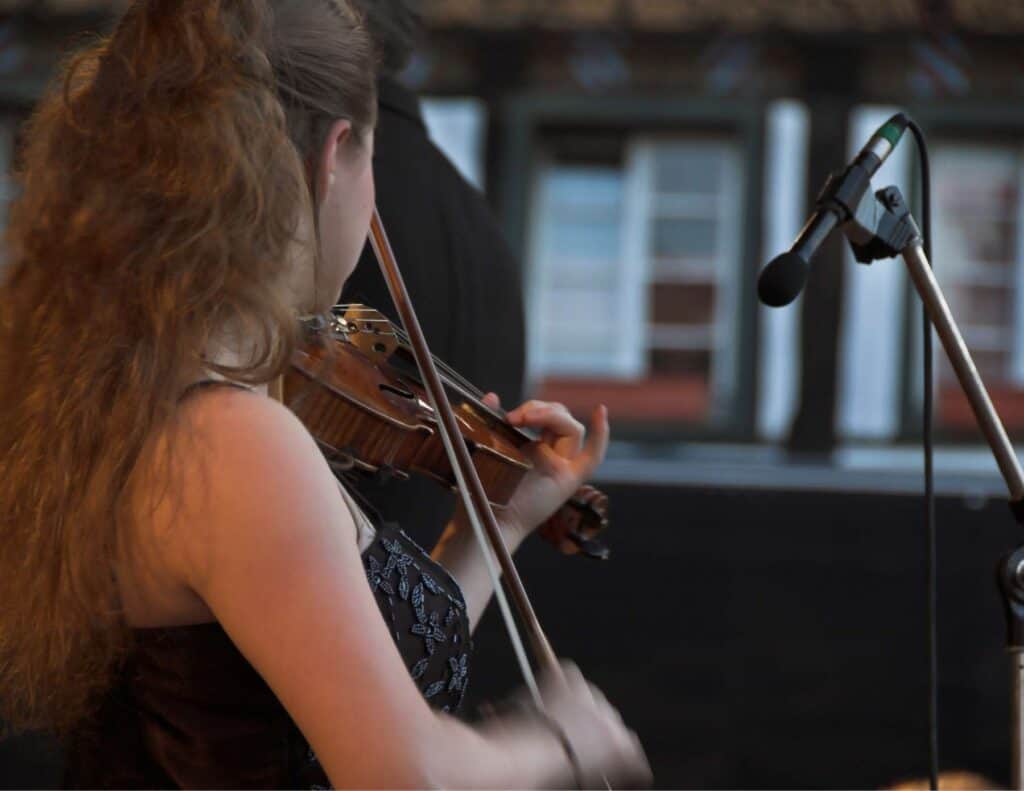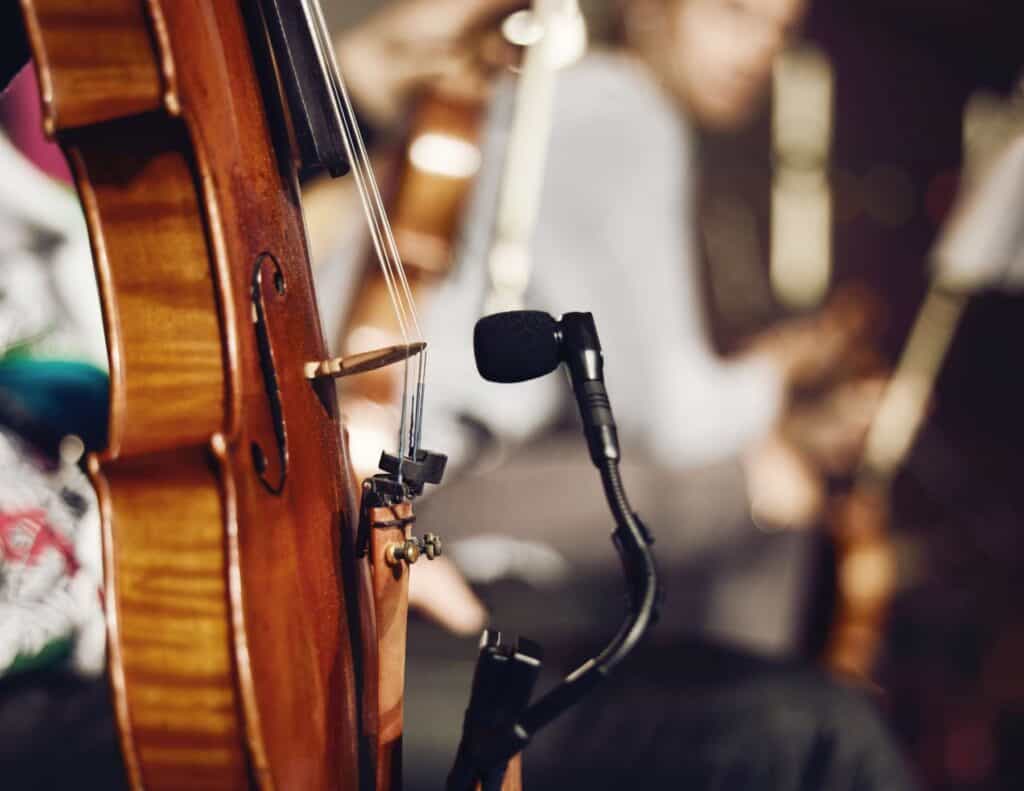
The violin, with its rich and soulful tones, is an instrument that demands precision in capturing its true essence. Miking it properly can make all the difference between a mediocre sound and an audio masterpiece.
The choice and positioning of a microphone play a pivotal role in capturing the violin’s true essence. And if you’ve ever been curious about how professionals attain such pristine recordings, you’ve landed in the right spot.
In this article, we will discuss the different types of microphones available and how to select the right one for your specific needs.
Key Takeaways:
- Understanding the unique sound characteristics of the violin is essential for mic’ing it properly.
- Selecting the right microphone and placement is crucial for capturing the desired sound.
- Techniques to mic a violin vary depending on the type of recording or performance, and understanding these techniques is essential for achieving optimal results.
Table of Contents
How to Mic a Violin
Mic a violin by positioning a small-diaphragm condenser microphone about 12-18 inches away from the F-holes, angling it slightly towards the bridge. Ensure a quiet environment, and use a high-pass filter to eliminate any low-frequency noise. Experiment with positioning for the best sound quality.
Before you even worry about mic placement, you first have to choose the right type of mic for the job. There are several types of microphones that can be used to capture the sound of a violin, but not all of them are created equal.
Condenser Microphones
Condenser microphones are a popular choice for miking violins. They are known for their ability to capture detailed, high-frequency sounds, which is important when recording the nuances of a violin. The Neumann U87 and AKG C414 are two examples of large-diaphragm condenser microphones that are often used to mic violins.
Small-diaphragm condenser microphones are also a popular option for miking violins. The AKG C451 is a small-diaphragm condenser microphone that is often used for this purpose. These microphones are known for their ability to capture the natural sound of the instrument, and are often used in classical music recordings.
Other Microphones
While condenser microphones are the most popular option for miking violins, there are other types of microphones that can be used as well.
- Dynamic microphones, for example, are known for their ability to handle high sound pressure levels, which can be useful when you need to mic a violin in a live setting.
- Ribbon microphones are also a popular option to mic a violin, as they can provide a warm, natural sound.
What to Consider
When selecting a microphone to mic a violin, there are several factors to consider. The first is the type of sound you want to achieve.
If you are looking for a warm, natural sound, a ribbon or small-diaphragm condenser microphone may be the best option.
If you want a more detailed, high-frequency sound, a large-diaphragm condenser microphone may be the way to go.
If you are recording in a noisy environment, a dynamic microphone may be the best option, as it can handle high sound pressure levels without distorting. If you are recording in a quiet environment, a condenser microphone may be a better choice, as it can capture the subtle nuances of the instrument.
Mic Techniques
Positioning
When it comes to mic positioning for a violin, there are a few things to keep in mind.
- First, it’s important to find a spot that captures the full range of sound from the instrument. One popular position is under the bridge, between the strings and the deck. This spot captures the sound of the soundboard as well as the “bite” when the strings are plucked or bowed.
- Another option is to place the mic a few inches away from the instrument, at a slight angle to capture the full range of sound.
Close Miking
Close miking involves placing the mic very close to the instrument, typically within a few inches. This technique can help capture a more intimate and detailed sound, but it can also pick up unwanted noise such as bowing or finger movements. To reduce these noises, it’s important to experiment with mic placement and use a directional mic to focus on the sound of the instrument.
Mic Setup
When setting up your microphone for a violin, there are a few things to keep in mind. First, it’s important to use a high-quality condenser mic that can capture the full range of sound from the instrument. Small diaphragm mics are more accurate and capable of capturing higher frequencies beyond human hearing, while large diaphragm condensers are preferred for their richer low-end response.
It’s also important to experiment with mic placement to find the sweet spot that captures the full range of sound from the instrument while minimizing unwanted noise. Finally, it’s important to use a shock mount or other vibration isolation device to reduce unwanted noise from handling or movement.

Types of Microphones
When you mic a violin, there are different types of microphones that you can use. Each type of microphone has its own unique characteristics that can affect the sound quality of the recording or performance.
Condenser Mic
Condenser microphones are one of the most common types of microphones used for recording violins. They are known for their high sensitivity and accuracy in capturing sound. Condenser mics have a diaphragm that vibrates in response to sound waves, which creates an electrical signal that is then amplified and recorded.
One advantage of using a condenser mic is that they are capable of capturing a wide range of frequencies, which makes them ideal for recording violins. They also tend to have a flat frequency response, which means that they do not color the sound of the instrument.
Ribbon Mic
Ribbon microphones are another type of microphone that can be used for miking violins. They have a thin metal ribbon that vibrates in response to sound waves, which creates an electrical signal that is then amplified and recorded.
Ribbon mics are known for their warm and natural sound, which makes them ideal for recording acoustic instruments like violins. They also have a figure-eight polar pattern, which means that they pick up sound from the front and back of the microphone, but not from the sides.
Directional Microphones
Directional microphones, also known as dynamic microphones, are a type of microphone that is commonly used for live performances. They are known for their ruggedness and ability to handle high sound pressure levels.
Directional microphones have a diaphragm that is attached to a coil of wire. When sound waves hit the diaphragm, it moves back and forth, which creates an electrical signal that is then amplified and recorded.
One advantage of using a directional microphone is that they are less sensitive to background noise, which makes them ideal for live performances. They also tend to have a cardioid polar pattern, which means that they pick up sound from the front of the microphone, but not from the sides or back.
Understanding Frequencies
The frequency range of a violin spans from around 196 Hz (G3) to 1319 Hz (E6). The sound of a violin is rich in harmonics and overtones, which makes it a complex instrument to mic.
It’s important to choose a microphone that can capture the full frequency range of the violin. Small diaphragm mics are more accurate and capable of capturing higher frequencies beyond human hearing. Large diaphragm condensers, on the other hand, are preferred for their richer low-end response.
All microphones have a polar pattern, which is the area around the mic that it picks up. The polar pattern of a microphone affects the amount of sound it picks up from different directions. For violin, a cardioid polar pattern is often preferred as it captures sound from the front while rejecting sound from the sides.
When positioning the microphone, it’s important to consider the distance between the mic and the violin. Placing the mic too close to the violin can result in a harsh, boomy sound, while placing it too far can result in a thin, weak sound. A good starting point is to place the mic about 6 inches away from the violin, pointing towards the bridge.

Room Acoustics
The sound of a violin is heavily influenced by the acoustics of the room it is played in. The reflective surfaces in a room can affect the sound of the violin by adding reverb, echo, and other sound reflections. Therefore, it is important to choose a room with good acoustics for recording or performing with a violin.
If you are recording a violin, it is best to find a room with a nice reflective surface and good acoustics. This will help to enhance the sound of the violin and capture its rich tonal quality. On the other hand, a small, dead-sounding space may cause the sound of the violin to be lost.
When you mic a violin, it is important to consider the room acoustics. The sound of the violin and the room will combine to form the overall sound picture. Therefore, it is essential to ensure that the room enhances the sound of the violin, rather than detracts from it.
One way to improve the acoustics of a room is to use acoustic treatment. This can include adding sound-absorbing materials, such as acoustic panels or curtains, to reduce unwanted reflections and improve the overall sound quality. Additionally, placing furniture or other objects in the room can help to break up sound waves and improve the acoustics.
Recording in Studio
When recording a violin in a studio, it is important to consider the acoustics of the room and the placement of the microphone. Here are some tips to help you get the best sound possible:
- Room Acoustics: Choose a room that has good acoustics for recording string instruments. A room with a lot of natural reverb can be ideal, but make sure it is not too boomy or echoey. If you are using a small room, consider using acoustic treatment to reduce unwanted reflections and improve the overall sound quality.
- Microphone Placement: The placement of the microphone is crucial when recording a violin. A good starting point is to place the microphone about 1-2 feet away from the instrument, pointed at the f-hole. You can experiment with different angles and distances to find the sweet spot that captures the full range of the instrument’s sound.
- Preamps and Converters: To get the best sound quality, it is important to use high-quality preamps and converters. These devices can help to boost the signal and reduce noise, resulting in a cleaner and more accurate recording. Consider investing in high-end equipment if you plan to do a lot of recording in the studio.
- Recording Techniques: There are several techniques you can use to record a violin in the studio. One popular method is to use two microphones, one placed above the instrument and one below, to capture the full range of the sound. You can also experiment with different microphone types and placements to achieve different tonal qualities.
Live Performance Miking
When you mic a violin for live performances, there are a few key factors to consider. First and foremost, the mic placement should be comfortable for the player and should not interfere with their performance.
Additionally, the mic should be positioned in a way that minimizes acoustic feedback and captures the best quality tone from the instrument.
There are a few different types of microphones that are suitable for live performance miking, including dynamic, condenser, and ribbon mics.
- Dynamic mics are particularly well-suited for live performances due to their sturdy build and ability to handle high sound pressure levels.
- Condenser mics, on the other hand, are ideal for capturing a more detailed sound and may be a better choice for recording purposes.
When it comes to mic placement, there are a few different options to consider. One common approach is to place the mic directly in front of the violin, about six to eight inches away from the instrument. This can help to capture the full range of the instrument’s sound, including both the higher and lower frequencies.
Another option is to use a clip-on microphone, which can be attached directly to the violin itself. This can be a good choice for players who move around a lot during their performance, as the mic will move with them and help to maintain a consistent sound.
Finally, it’s worth noting that mic placement may need to be adjusted depending on the type of performance being given. For example, if the player is primarily using pizzicato (plucking) rather than bowing, the mic placement may need to be adjusted to capture the different sound produced by this technique.

Additional Considerations
Viola and Cello
While the guidelines to mic a violin can generally be applied to violas and cellos, there are a few additional considerations to keep in mind.
Violas and cellos have a lower range than violins, so it may be necessary to position the microphone closer to the f-hole to capture the instrument’s natural sound.
Additionally, larger diaphragm condenser microphones (in a cardioid pattern) are typically used to capture the full range of these instruments.
Proximity Effect
Proximity effect is a phenomenon that occurs when a microphone is placed too close to the sound source. This can lead to a boost in low frequencies, which can result in a boomy or unnatural sound.
To avoid this, it’s important to position the microphone at an appropriate distance from the instrument. Generally, placing the microphone one to three feet away from the instrument can help to minimize proximity effect.
Transient Response
Transient response refers to a microphone’s ability to accurately capture the fast, transient sounds of an instrument. This is particularly important when you mic a violin, as the instrument produces a lot of high-frequency transients.
Condenser microphones are typically better suited for capturing these transients than dynamic microphones. Additionally, microphones with a flat frequency response are ideal for capturing the natural sound of the instrument without adding any harshness or coloration.
Frequently Asked Questions
What are the best microphones for recording violin?
Large diaphragm condenser microphones in a cardioid pattern are generally a good choice for recording violins, violas, and cellos. Small-diaphragm omnidirectional mics or ribbons can also produce pleasing results. Ultimately, the best microphone choice depends on the specific recording situation and personal preference.
How do you position microphones for recording a violin?
Positioning the microphone under the bridge, between the strings and the deck, is a common and effective method for capturing the sound of the soundboard and the “bite” of the strings when plucked or bowed. It is also important to experiment with distance from the instrument and microphone angle to achieve the desired sound.
What is the difference between a condenser and dynamic microphone for recording a violin?
Condenser microphones are typically more sensitive and responsive to high frequencies, making them a popular choice for recording acoustic instruments like violins. Dynamic microphones, on the other hand, are less sensitive and better suited for capturing loud, high-energy sound sources like drums or guitar amps.
Can you use a ribbon microphone for recording a violin?
Yes, ribbon microphones can be a great choice for recording violins, as they tend to produce a smoother, more mellow sound. However, it is important to ensure that the microphone can handle the high frequencies produced by the instrument without distorting or becoming damaged.
What is the best way to edit a violin recording?
When editing a violin recording, it is important to maintain the natural sound of the instrument while also addressing any technical issues like background noise or uneven levels. This can involve using EQ to enhance the desired frequencies, adjusting levels to balance the sound, and adding effects like reverb or compression as needed.
How do you record a solo violin performance?
When recording a solo violin performance, it is important to choose a quiet and acoustically appropriate space. Using a high-quality microphone and positioning it properly can help capture the nuances of the performance. It is also important to experiment with different microphone placements and recording techniques to achieve the desired sound.

